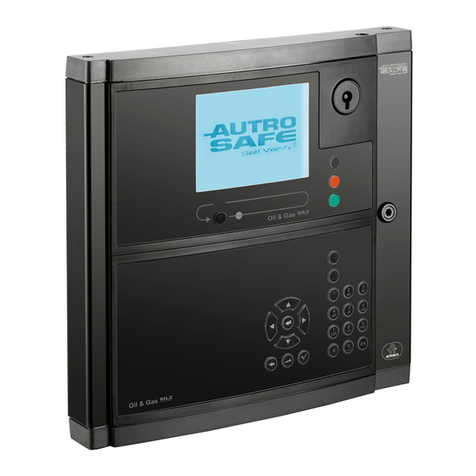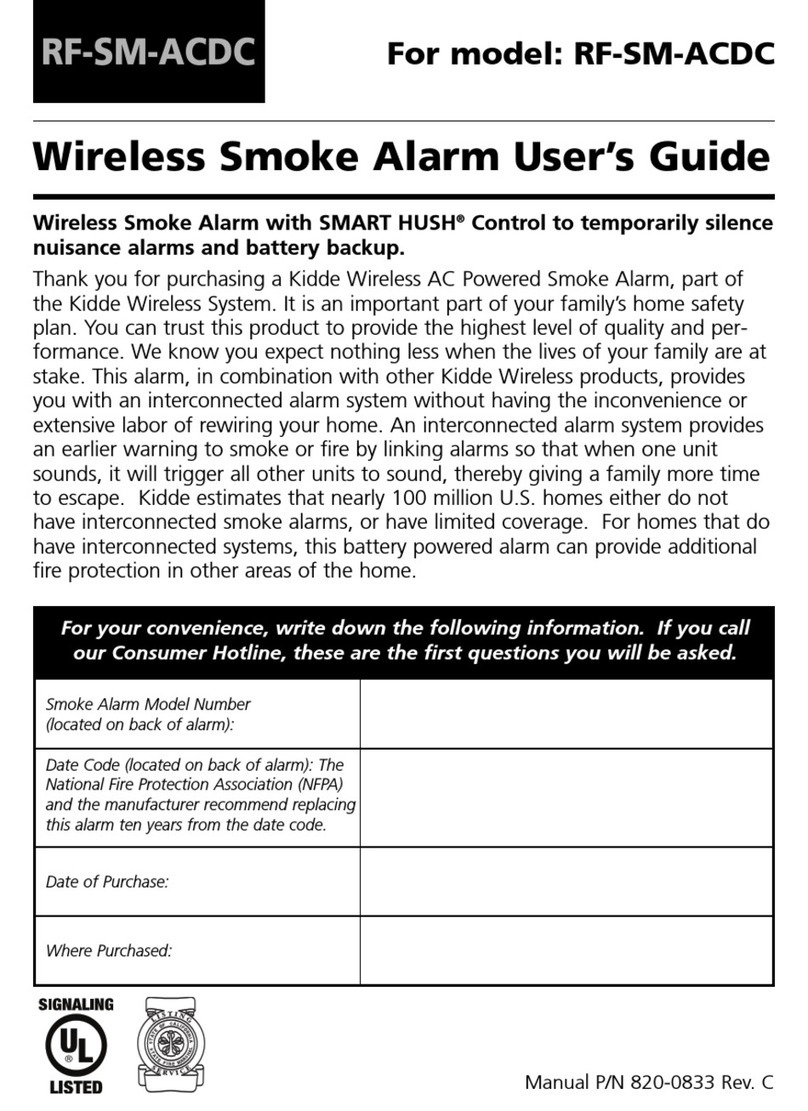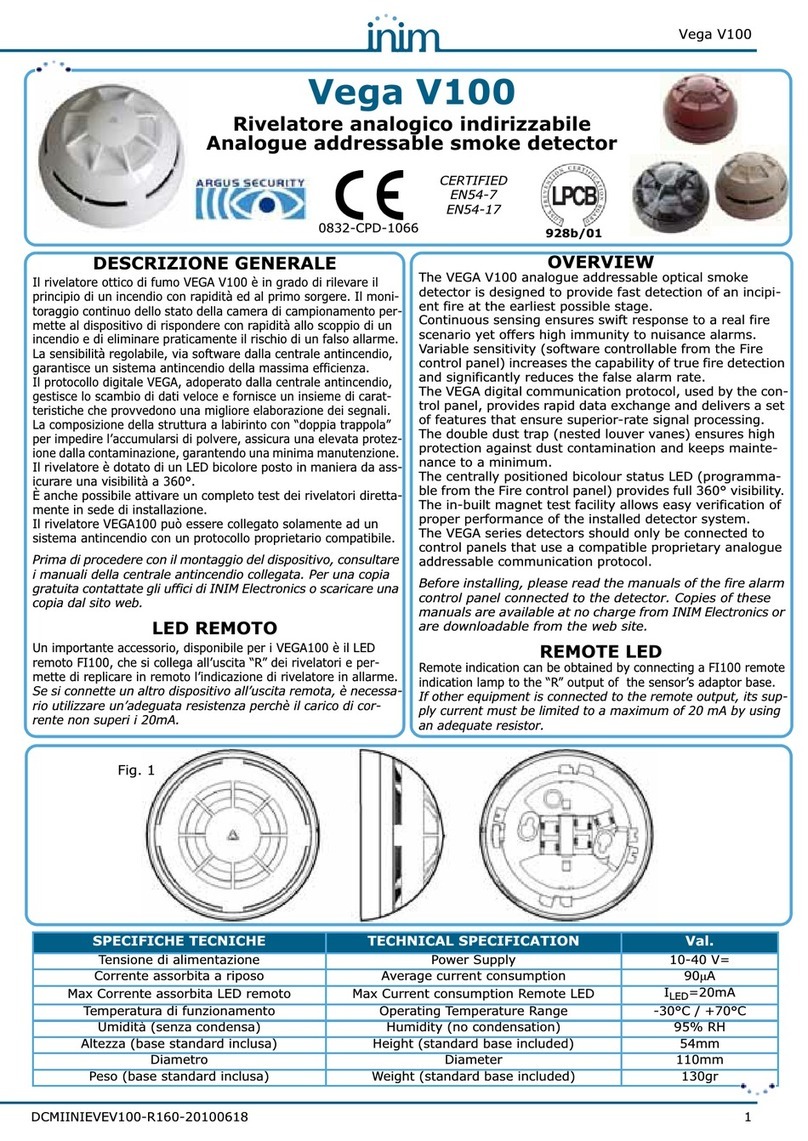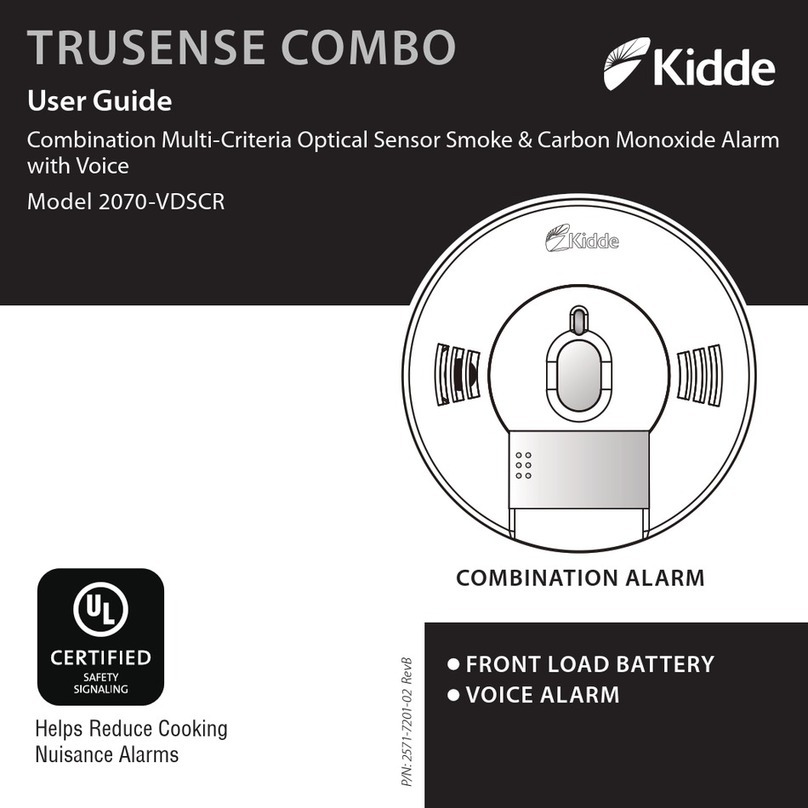merten 663819 User manual

D
GB
NL
Rauchmelder Basic 663819
Smoke detector Basic
Rookmelder Basic
Montage- und Betriebsanleitung
Installation and operation instructions
Montage- en gebruiksaanwijzing

2
Inhalt
Inhalt
1. Produktmerkmale 3
2. Funktionsweise 4
3. VdS-Anerkennung 5
4. Technische Daten 5
5. Sicherheitshinweise 7
6. Montageort 8
7. Montage 10
8. Ungeeignete Montageorte 12
9. Falschalarme 12
10. Funktionskontrolle 13
11. Im Betrieb 20
12. Wartung und Pflege 21
13. Vorsorge & Verhalten im Brandfall 23
Bitte lesen Sie vor der Inbetriebnahme des Rauchmelders
diese Montage- und Betriebsanleitung vollständig durch.
3
1. Produktmerkmale
1. Produktmerkmale
• Batteriebetriebener optischer Rauchmelder nach dem Streu-
lichtprinzip.
• Automatischer Selbsttest der Rauchauswertung, dadurch äu-
ßerst zuverlässig und extrem störsicher.
• Lauter pulsierender Warnton bei Raucherkennung, etwa
85 dB(A).
• Batteriewechselanzeige (Leuchtdiode und kurzer Signalton)
meldet 30 Tage lang eine schwächer werdende Batterie.
• Verschmutzungs-/Störungsanzeige mit kurzem Signalton
alle 30 sec und abwechsend dazu blinkt die Leuchtdiode.
• Integrierter Testknopf;ertönt beim Betätigen des Testknopfes
der Warnton, arbeitet der Rauchmelder korrekt.
• Batteriefachkontrolle; ist im Rauchmelder keine Batterie ein-
gelegt, lässt er sich nicht im Sockel arretieren.
• Verpolschutz;eine Gerätezerstörung durch falschen Batterie-
anschluss ist nicht möglich.
• Lebensdauer der Batterie: ca. 2 Jahre (Alkaline-Batterie)
• Der Rauchmelder ist in der Ausführung polarweiß erhältlich.

4
2. Funktionsweise
2. Funktionsweise
Der Melder arbeitet nach dem optischen Streulichtprinzip (es
werden keine radioaktiven Materialien eingesetzt).
Er besitzt eine Messkammer, in der eindringender Rauch mittels
Infrarotlicht erkannt wird. Wird die Alarmschwelle überschritten,
ertönt der akustische Signalgeber und der optische Signalgeber
(rote Leuchtdiode am Melder) leuchtet. Die Signalgeber werden
automatisch zeitverzögert abgeschaltet, sobald die Messkam-
mer wieder rauchfrei ist.
3. Prüfungs-Anerkennung
Dieser ARGUS Rauchmelder hat die Anerkennung entsprechen-
der Prüfstellen erhalten (VDS Schadenverhütung GmbH, BO-
SEC). Diese Anerkennung erhalten nur Sicherheitsprodukte, die
deren hohen qualitativen Anforderungen entsprechen
(pr EN ISO 12239, EN 14604;TCC2/BOSEC/9195).
Wichtige Prüfkriterien sind unter anderem:
- sicheres Rauch-Ansprechverhalten,
- gutes Rauch-Eintrittsverhalten,
- Unempfindlichkeit gegenüber elektrostatischen Entladungen,
- Funktions- und Einsatzkontrolle der Batterie,
- Testknopf-Funktion.
5
4. Technische Daten
4. Technische Daten
Batterie (Alkaline) 9 V, Blockbatterie, 6LR61
Batterielebensdauer ca. 2 Jahre
Batterieausfallsignal alle 45 Sek. , 30 Tage
Ansprechempfindlichkeit gemäß pr EN ISO 12239,
EN 14604
Lautstärke des Signalgebers ca. 85 dB(A) in 3 m Abstand
Optische Anzeige LED, rot
Zulässige Windgeschwindigkeit 20 m/s max.
Betriebstemperaturbereich 0°C bis +60°C
Schutzart IP 42
Abmessung ∅ x H 100 x 38 mm
VdS-Anerkennung siehe Typenschild

6
5. Sicherheitshinweise
5. Sicherheitshinweise
• Der Rauchmelder darf nicht mit Farbe überstrichen werden.
• Der laute Warnton kann das Gehör schädigen. Wir empfehlen,
bei der Durchführung des manuellen Tests eine Armlänge Ab-
stand zwischen Rauchmelder und Ohr einzuhalten sowie den
Test nicht länger als 10 Sekunden ablaufen zu lassen.
• Rauchmelder löschen keinen Brand. Prüfen sie bei Alarm vor-
sichtig ,ob es sich um einen Brand handelt, und rufen Sie gege-
benenfalls die Feuerwehr, falls der Brand nicht mit eigenen Mit-
teln zu löschen ist (siehe auch Kap. 13).
• Der Rauchmelder arbeitet nur mit einer funktionstüchtigen, kor-
rekt eingelegten Batterie.
• Wiederaufladbare Batterien (Akkus) oder Netzgeräte dürfen
nicht verwendet werden, sie können Funktionsstörungen oder
vorzeitigen Ausfall des Geräts hervorrufen.
• Der Rauchmelder erkennt den Rauch eines Brandes und nicht
die Flamme selbst.
• Der Rauchmelder überwacht einen bestimmten Bereich im
Umfeld seines Montageortes und nicht unbedingt andere Zim-
mer oder andere Stockwerke (siehe auch Kap. 6 und 7).
• Installieren Sie daher ausreichend viele Rauchmelder, um einen
optimalen Schutz zu gewährleisten.
7
6. Montageort (siehe Abb. 1)
• Der Rauchmelder sollte im gesamten Wohnbereich zu hören
sein. Installieren Sie ggf. zusätzliche Signalquellen, z. B. eine Hu-
pe.
• Menschen unter Alkohol- oder Drogeneinfluss werden von
dem Signalton möglicherweise nicht geweckt.
6. Montageort (siehe Abb. 1)
Mindestschutz
• Im Flur wird zwischen Wohn- und Schlafbereich ein Rauchmel-
der angebracht.
• Bei langen Fluren sind gegebenenfalls mehrere Melder erfor-
derlich. Der Abstand zwischen den Meldern sollte nicht größer
als 8 m sein.
• Bei mehreren getrennten Schlafbereichen sollte vor jedem
Schlafbereich ein Melder installiert werden.
• Bei mehrgeschössigen Wohnungen sollte in jedem Stockwerk
ein Melder im Flur angebracht werden.

8
6. Montageort (siehe Abb. 1)
Erhöhter Schutz
• Zusätzlich zum Mindestschutz wird in jedem Raum ein Rauch-
melder installiert. Ein Melder kann Räume bis zu max. 60 m2und
6 m Höhe überwachen.
• Der Melder soll in Raummitte an der Decke angebracht werden.
• Falls dies nicht möglich ist, sollte der Abstand zu Wänden min-
destens 50 cm betragen.
Abb. 1
9
7. Montage (siehe Abb. 2)
7. Montage (siehe Abb. 2)
Montieren Sie den Rauchmelder nach folgenden Schritten:
1. Den Sockel mit dem beiliegenden Montagematerial an die
Decke montieren. Keine Senkkopfschrauben verwenden.
2. Die 9-V-Blockbatterie (4) mit dem Batterieanschluss (3) ver-
binden und in den Batteriehalter stecken.
3. Den Rauchmelder ohne Gewaltanwendung in den Sockel
führen und nach rechts drehen, bis er einrastet.
4. Hinweis: Ohne eingelegte Batterie rastet der Rauchmelder
nicht im Sockel ein.
5. Führen Sie die Funktionskontrolle durch (siehe Kapitel 10).

10
7. Montage (siehe Abb. 2)
Abb. 2: Aufbau des Rauchmelders
1 Rauchmelder 2 Testknopf
3 Leuchtdiode 4 Öffnungen für Sirene
5 Sockel 6 Batterie
7 Batterieanschluss
1
7
6
2
3
5
4
11
8. Ungeeignete Montageorte
8. Ungeeignete Montageorte
• Stellen, an denen größere Temperaturschwankungen als der
Betriebstemperaturbereich (0 - 60 °C) zu erwarten sind.
• Stellen, an denen Zugluft den Rauch vom Melder fernhalten
kann, z. B. neben Fenstern, Türen oder Lüftungsschächten.
• Stellen, an denen durch Dämpfe, erhöhte Luftfeuchtigkeit oder
Abgase Falschalarme ausgelöst werden können.
• Bei der Installation des Melders in der Küche muss deshalb der
Montageort möglichst weit vom Kochbereich entfernt sein, um
Falschalarme durch Dampf zu vermeiden.
• Stellen, an denen durch hohe Staub- und Schmutzbelastung die
Funktion des Melders beeinträchtigt werden kann.
• In unmittelbarer Nähe von Beleuchtungskörpern und Vorschalt-
geräten. Halten Sie dazu einen Abstand von mindestens 1 m.
• Direkt in einer Dachspitze. Ein Abstand von mindestens 30 cm
zur Dachspitze ist einzuhalten.
• In der Nähe von Feuerstellen und offenen Kaminen.
9. Falschalarme
Trotz Falschalarmlogik können Rauchmelder unter ungünstigen
Bedingungen Falschalarme auslösen. Starke Dampfentwicklung
oder viel Staub in der Umgebungsluft können der Grund dafür
sein. Bitte beachten Sie diese Umstände bei der Auswahl des

12
10. Funktionskontrolle
Montageorts. Sollte der Rauchmelder wiederholt Falschalarme
auslösen, bringen Sie ihn an einem alternativen Ort an.
Je nach Montageort unterliegt der Rauchmelder nach ca. 10 Jah-
ren einer altersbedingten Verschmutzung der Messkammer, was
zu Falschalarmen führen kann. In diesem Fall ist der Rauchmel-
der auszutauschen.
10. Funktionskontrolle
Achtung: Der Rauchmelder erzeugt einen sehr lauten Ton,
der das Gehört schädigen kann. Halten Sie deshalb bei der
Funktionskontrolle den Mindestanstand einer Armlänge ein.
Kontrollieren Sie wie folgt:
1. Testknopf betätigen. Ertönt ein pulsierender Warnton und
blinkt die Leuchtdiode für die Dauer der Betätigung, arbeitet der
Rauchmelder korrekt. Anderenfalls prüfen Sie den Batteriean-
schluss bzw. tauschen Sie die Batterie aus.
2. Funktionskontrolle nach Batteriewechsel wiederholen. Er-
tönt kein Warnton, ist der Rauchmelder defekt und muss ersetzt
werden.
13
11. Im Betrieb
11. Im Betrieb
Der Rauchmelder erkennt einen Brand an seiner Rauchentwick-
lung.
Wenn die Messkammer nach einem Alarm wieder rauchfrei ist,
setzt sich der Melder nach ca. 30 Sek. automatisch wieder in den
Bereitschaftsbetrieb zurück.
Die Rauchauswertung wird in einem Selbsttest ständig über-
prüft. Eine Fehlfunktion z. B. durch Verschmutzung wird durch ein
Störungssignal (Signalton und Leuchtdiode) angezeigt.
Der Batterietest überprüft kontinuierlich die Versorgungsspan-
nung. Sobald die Batteriespannung unter einen definierten Punkt
sinkt, meldet der Rauchmelder 30 Tage lang, dass die Batterie
gewechselt werden muss. Während dieser Zeit ist der Rauch-
melder voll funktionsfähig.

14
12. Wartung und Pflege
Tab el le
12. Wartung und Pflege
Um die Funktionssicherheit des Rauchmelders über einen langen
Zeitraum zu gewährleisten, sind die folgenden Punkte zu beach-
ten:
Wenn sich der Rauchmelder im 30 Sek. Takt durch ein kurzes
akustisches Signal bei gleichzeitigem Blinken der Leuchtdiode
meldet, ist innerhalb der nächsten 30 Tage die Batterie zu erset-
zen. Verwenden Sie ausschließlich eine 9 V Alkaline Blockbatte-
rie nach IEC 6LR61.
Signalton Leuchtdiode Bedeutung
- blinkt alle 30 s automatischer Selbsttest,
normaler Betriebszustand
lauter Intervall-
ton
blinkt lokaler Rauchalarm oder
Funktionstest
lauter Intervall-
ton
- externer Rauchalarm; nur bei
vernetzten Rauchmeldern
Kurzer Signal-
ton alle 30 s
blinkt abwech-
selnd mit dem
Signalton
Störung / Verschmutzung
Kurzer Signal-
ton alle 30 s
blinkt parallel
zum Signalton
Batteriewechselanzeige
15
12. Wartung und Pflege
Monatlich
Führen Sie 1x pro Monat eine Funktionskontrolle durch (siehe
Kap. 10).
Halbjährlich
Sie sollten ca. halbjährlich (oder bei einer Störungsmeldung) eine
Wartung durchführen. Gehen Sie dazu folgendermaßen vor:
1. Nehmen Sie den Rauchmelder aus dem Sockel (gegen den
Uhrzeigersinn drehen). Falls vorhanden, Modul abnehmen.
2. Entfernen Sie vorsichtig den Staub mit einem Pinsel o.ä. Ver-
wenden Sie dazu keine Druckluft.
3. Wischen Sie den Rauchmelder mit einem feuchten Tuch ab.
4. Stecken Sie den Rauchmelder (mit eingesetztem Modul,
falls vorhanden) wieder in den Sockel und drehen Sie ihn im Uhr-
zeigersinn, bis er einrastet.
Achtung: Ohne eingelegte Batterie lässt sich der Rauchmel-
der nicht im Sockel arretieren.
5. Prüfen Sie, ob der automatische Selbsttest durchgeführt
wird (die Leuchtdiode im Rauchmelder blinkt alle 30 Sekunden).
6. Führen Sie eine Funktionskontrolle durch (siehe Kap. 10).
Wir empfehlen, die Rauchmelder nach 10 Jahren auszutau-
schen.

16
13. Vorsorge und Verhalten im Brandfall
13. Vorsorge und Verhalten im Brandfall
• Erstellen Sie einen Fluchtplan und besprechen und üben Sie ihn
mit Ihrer Familie für den Notfall.
• Bestimmen Sie einen Ort außerhalb Ihres Hauses als Treff-
punkt im Falle eines Feuers.
• Machen Sie jeden mit dem Geräusch und der zusätzlichen Alar-
mierung des Rauchmelderalarmsystems bekannt.
Was tun bei Alarm?
• Sollte der Rauchmelder einen Alarm melden, prüfen Sie vor-
sichtig, ob Brandherde existieren. Wenn der Brand mit eigenen
Mitteln, wie Feuerlöschdecke oder Feuerlöscher, nicht gelöscht
werden kann, verlassen Sie sofort das Haus laut dem erstellten
Fluchtplan.
• Öffnen Sie keine Tür ohne vorher die Oberfläche zu befühlen.
Ist die Tür heiss oder strömt Rauch unter der Tür hinein, dann öff-
nen Sie diese Tür nicht, sondern benutzen einen alternativen
Fluchtweg.
• Halten Sie sich nah am Boden, wenn die Luft rauchig ist. Atmen
Sie durch ein Tuch, das wenn möglich befeuchtet ist.
• Rufen Sie die Feuerwehr vom Haus Ihrer Nachbarn – nicht von
Ihrem!
• Begeben Sie sich nicht zurück ins Haus, bis es Ihnen Ihre Feu-
erwehr erlaubt.

Rauchmelder Basic
Smoke detector Basic 663819
Rookmelder Basic
Montage- und Betriebsanleitung
Installation and operation instructions
Montage- en gebruiksaanwijzing

20
Contents
Contents
1. Product features 27
2. Operation 28
3. VdS approval 29
4. Technical data 29
5. Safety instructions 31
6. Installation site 32
7. Installation 34
8. Unsuitable installation sites 36
9. False alarms 36
10. Functional check 37
11. Operation 44
12. Maintenance and care 45
13. Precautions & action in the event of fire 47
Please read these installation and operating instructions in
full before putting the smoke detector into operation.
21
1. Product features
1. Product features
• Battery-operated optical smoke detector operating according
to the scattered light principle.
• Automatic self-test of the smoke evaluation, thereby excep-
tionally reliable and extremely trouble-free.
• Loud pulsating warning sound when smoke is detected, ap-
prox. 85 dB(A).
• Battery change display (LED and short signal tone) indicates a
battery becoming low for typically 30 days
• Dirt/malfunction display with a short signal tone every
30 seconds and an LED which flashes in contrasting rhythm to
the signal.
• Integrated test button: if the warning sound is emitted when
the test button is pressed, the smoke detector is operating cor-
rectly..
• Battery compartment check: if there is no battery inserted in
the smoke detector, the latter cannot be fixed in the base.
• Reverse battery protection: it is not possible for the device to
be destroyed by connecting the battery incorrectly.
• Service life of the battery: approx. two years (alkaline battery)
• The smoke detector is available in polar white.

22
2. Operation
2. Operation
The detector operates according to the optical scattered light
principle (no radioactive materials).
It has a measuring chamber in which incoming smoke is detected
by infrared light. If the alarm threshold is exceeded, the acoustic
signal transmitter sounds and the optical signal transmitter (red
LED on the detector) lights up. The signal transmitters are
switched off automatically with a time delay as soon as the
measuring chamber is smoke-free again.
3. VdS approval
This ARGUS smoke detector has been approved by the appropri-
ate inspection authorities (VDS Schadenverhütung GmbH,
BOSEC). This approval is only awarded to safety devices which
fulfil their high quality standards (pr EN ISO 12239; EN 14604;
TCC 2/BOSEC/9195).
Important test criteria include:
- reliable smoke responsivity,
- good smoke entry,
- immunity to electrostatic discharge,
- check on function and use of the battery,
- test button function.
23
4. Technical data
4. Technical data
Battery (alkaline) 9 V, monobloc battery,
6LR61
Service life of battery approx. two years
Battery failure signal every 45 sec. , 30 days
Responsivity according to EN 14604
Loudness of signal transmitter approx. 85 dB(A) at 3 m
distance
Optical display Red LED
Admissible wind velocity 20 m/s max.
Operating temperature range 0°C to +60°C
Protection type IP 42
Dimensions (∅x H) 100 x 38 mm
VdS approval see type plate

24
5. Safety instructions
5. Safety instructions
• The smoke detector must not be coated in paint.
• The loud warning sound may damage your hearing. We recom-
mend you keep the smoke detector at arm's length when carry-
ing out the manual test and that the test is not allowed to run for
longer than 10 seconds.
• Smoke detectors do not extinguish a fire. In the event of an
alarm, carefully check to see whether it was caused by a fire and
call the fire brigade if necessary if you are not in a position to ex-
tinguish the fire yourself. (See also Chapter 13)
• The smoke detector operates only with a functioning, correctly
inserted battery.
• Rechargeable batteries (accumulators) or power packs must
not be used, they can cause malfunction or premature failure of
the device.
• The smoke detector detects the smoke of a fire and not the
flame itself.
• The smoke detector monitors a specific zone in the surround-
ings of where it is fitted and not necessarily other rooms or other
storeys (see also Chapters 6 and 7).
• Therefore install a sufficient number of smoke detectors to en-
sure optimal protection.
25
6. Installation site (see Fig. 1)
• It should be possible to hear the smoke detector in the entire
living area. Install additional signal sources if necessary, e.g.
a horn.
• Persons under the influence of alcohol or drugs may not be
roused by the signal tone.
6. Installation site (see Fig. 1)
Minimum protection
• One smoke detector is fitted in the corridor between the living
and sleeping areas.
• In the case of long passageways, several detectors may be nec-
essary. The distance between the detectors should be no greater
than 8 m.
• In the case of several separate sleeping quarters, one detector
should be installed in front of each one.
• For multi-storey accommodation, one detector should be fitted
in the hall of each storey.

26
6. Installation site (see Fig. 1)
Increased protection
• In addition to the minimum protection, one smoke detector is
installed in each room. One detector can monitor rooms up to
max. 60 m2and 6 m in height.
• The detector should be fitted on the ceiling in the centre of the
room.
• If this is not possible, the distance from the walls should be at
least 50 cm.
Fig. 1
27
7. Installation (see Fig. 2)
7. Installation (see Fig. 2)
Fit the smoke detector according to the following steps:
1. Mount the base of the smoke detector using the materials
supplied. Do not use countersunk screws.
2. Connect the 9 V monobloc battery (4) to the battery
connection (3) and insert in the battery holder.
3. Insert the smoke detector into the base without exercising
any force and turn it clockwise until it locks into position.
4. Note: The smoke detector will not lock into the base if a
battery is not inserted.
5. Perform the functional check. (See Chapter 10)

28
7. Installation (see Fig. 2)
Fig. 2: Structure of the smoke detector
1 Smoke detector 2 Test button
3 LED 4 Opening for signal sound
5 Base 6 Battery
7 Battery connection
1
7
6
2
3
5
4
29
8. Unsuitable installation sites
8. Unsuitable installation sites
• Places where higher temperature fluctuations than the operat-
ing temperature range (0°C to +60°C) are to be expected.
• Places where draughts can keep the smoke away from the de-
tector (e.g. next to windows, doors or air shafts).
• Places in which false alarms may be set off by steam, increased
humidity or waste gas.
• If the detector is installed in the kitchen, the place where it is
fitted must therefore be as far away as possible from the cooking
area so as to avoid false alarms due to steam.
• Places in which the function of the detector may be adversely
affected by being exposed to a large amount of dust and dirt.
• In the direct vicinity of lighting fixtures and ballast units. Main-
tain a distance of at least 1 m from them.
• Directly in the apex of a roof. A distance of at least 30 cm is to
be maintained from the apex of a roof.
• Near hearths or open fireplaces.
9. False alarms
In spite of false alarm logic, smoke detectors may give false
alarms in adverse conditions. They may be caused by intense de-
velopment of steam or a large amount of dust in the ambient air.
Please pay attention to these circumstances when selecting the

30
10. Functional check
installation site. Should the smoke detector repeatedly set off
false alarms, fit it in an alternative location.
Depending on where it is installed, after about 10 years dirt is li-
able to accumulate in the measuring chamber of the smoke de-
tector due to age and may lead to false alarms. In this case the
smoke detector is to be replaced.
10. Functional check
Attention: The smoke detector produces a very loud sound
that can damage hearing. Therefore when carrying out the
functional check, remain at least an arm's length away from
the device.
Carry out the check as follows:
1. Press the test button. If a pulsating warning sound is set off
and the light-emitting diode flashes throughout, the smoke de-
tector is operating correctly. Otherwise check the battery con-
nection or change the battery.
2. Repeat the functional check after changing the battery. If no
warning sound is triggered, the smoke detector is defective and
must be replaced.
31
11. Operation
11. Operation
The smoke detector detects a fire from the smoke it forms.
When the measuring chamber is smoke-free again after an alarm,
the detector automatically reverts to the stand-by mode after ap-
prox. 30 sec.
The evaluation of smoke is constantly checked in a self-test. Any
malfunction, e.g. as a result of dirt, is indicated by a fault signal
(signal sound and LED).
The battery test continuously checks the supply voltage. As
soon as the battery voltage drops below a defined point, the
smoke detector indicates typically for 30 days that the battery
has to be changed. During this time the smoke detector is fully
operational.

32
12. Maintenance and care
12. Maintenance and care
The following points must be observed in order to ensure the
functional safety of the smoke detector over a long period:
If the smoke detector emits a short acoustic signal accompanied
the LED flashing at 30 second intervals, the battery must be re-
placed within the next 30 days. Use only a 9 V alkaline monobloc
battery according to IEC 6LR61.
Signal sound LED Meaning
- Flashes every
30 s Automatic self-test,
normal operating status
Loud
intermittent
sound
Flashes Smoke detected locally or
functional test
Loud
intermittent
sound
- Smoke detected
externally; only possible
with networked detectors
Short signal
sound every 30 s Flashes
alternating with
the signal sound
Malfunction / dirt
Short signal
sound every 30 s Flashes parallel to
the signal sound Battery change indication
33
12. Maintenance and care
Monthly
Carry out a functional check once a month (see Chapter 10).
Every six months
Maintenance should be carried out approximately every six
months (or when malfunction is indicated). To do so proceed as
follows:
1. Remove the smoke detector from the base (turn it counter-
clockwise). Detach module, if any.
2. Carefully remove the dust using a paintbrush or similar. Do
not use compressed air for this purpose.
3. Wipe the smoke detector with a damp cloth.
4. Insert the smoke detector (with inserted module, if any) back
into the base and turn it clockwise until it locks into position.
Attention: The smoke detector cannot be locked in the base
if a battery is not inserted.
5. Check whether the automatic self-test is carried out (the
LED in the smoke detector flashes every 40 seconds).
6. Carry out a functional check (see Chapter 10).
We recommend replacing the smoke detector after 10 years.

34
13. Precautions & action in the event of fire
13. Precautions & action in the event of fire
• Work out an escape plan. Discuss and practice it with your fam-
ily for emergencies.
• Decide on a location outside your house to act as a meeting
point in the event of a fire.
• Familiarise yourself with all the sounds and other alarm indica-
tions of your smoke detector alarm system.
What to do in the event of an alarm
• If the smoke detector sets off an alarm, carefully check whether
any fire sources exist. If you cannot extinguish the fire with your
own equipment such as fire blankets or fire extinguishers, leave
the house immediately according to the escape plan you have
worked out.
• Do not open any doors without first feeling its surface. If the
door is hot or smoke is streaming in under the door, then do not
open that door. Use an alternative escape route instead.
• If the air is smoky, stay close to the ground. Breath through a
cloth - a damp cloth if possible.
• Call the fire brigade from a neighbour's house – not from your
own!
• Do not re-enter your house until the fire brigade allows you to
do so.

Rauchmelder Basic
Smoke detector Basic
Rookmelder Basic 663819
Montage- und Betriebsanleitung
Installation and operation instructions
Montage- en gebruiksaanwijzing

38
Inhoud
Inhoud
1. Productkenmerken 51
2. Gebruikswijze 52
3. VdS-goedkeuring 53
4. Technische gegevens 53
5. Veiligheidsaanwijzingen 55
6. Montageplaats 56
7. Montage 58
8. Ongeschikte montageplaatsen 60
9. Valsalarm 60
10. Functie controle 61
11. In bedrijf 68
12. Onderhoud 69
13. Voorzorg & handelen in geval van brand! 71
Lees voor ingebruikneming van de rookmelder deze monta-
ge- en gebruiksaanwijzing geheel door.
39
1. Productkenmerken
1. Productkenmerken
• Optische rookmelder met batterijvoeding op basis van het
strooilichtprincipe.
• Automatische controle van de rookanalyse, daardoor uiterma-
te betrouwbaar en extreem zeker tegen storingsvrij.
• Luid pulserend waarschuwingssignaal bij rookherkenning,
ongeveer 85 dB(A).
• Batterijvervangingsindicatie (lichtdiode en korte signaaltoon)
meldt typ. 30 dagen lang een zwakker wordende batterij.
• Vervuiling-/storingweergave met korte signaaltoon iedere
30 s en daarbij knippert afwisselend de LED.
• Geïntegreerde testknop; weerklinkt bij het drukken van de test-
knop het waarschuwingsignaal, dan werkt de rookmelder cor-
rect.
• Batterijvakcontrole; is in de rookmelder geen batterij ingelegd,
kan deze niet in de sokkel worden gedraaid.
• Beschering verwisseling +/- pool;een vernietiging van het ap-
paraat door verkeerde aansluiting van de batterij is niet mogelijk.
• Levensduur van de batterij: ca. 2 jaar (alkaline-batterij)
• De rookmelder is verkrijgbaar in de uitvoering polarwit.
Table of contents
Languages:
Other merten Smoke Alarm manuals
Popular Smoke Alarm manuals by other brands
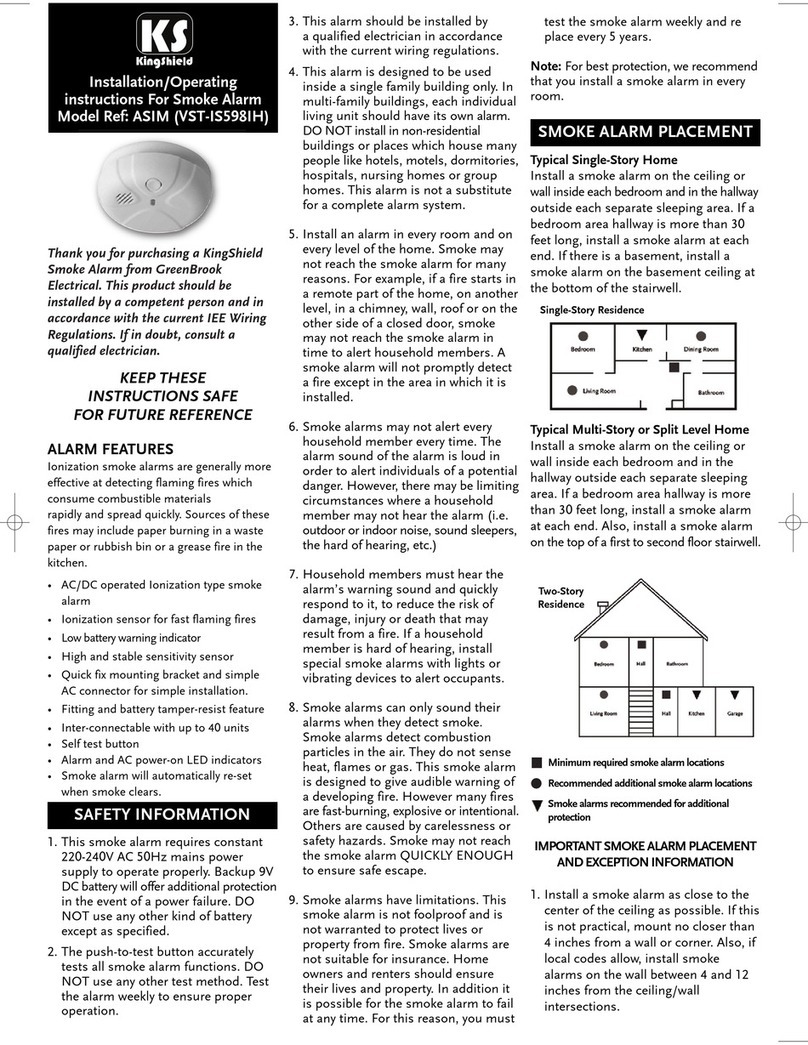
KingShield
KingShield ASIM VST-IS598IH Installation & operating instructions
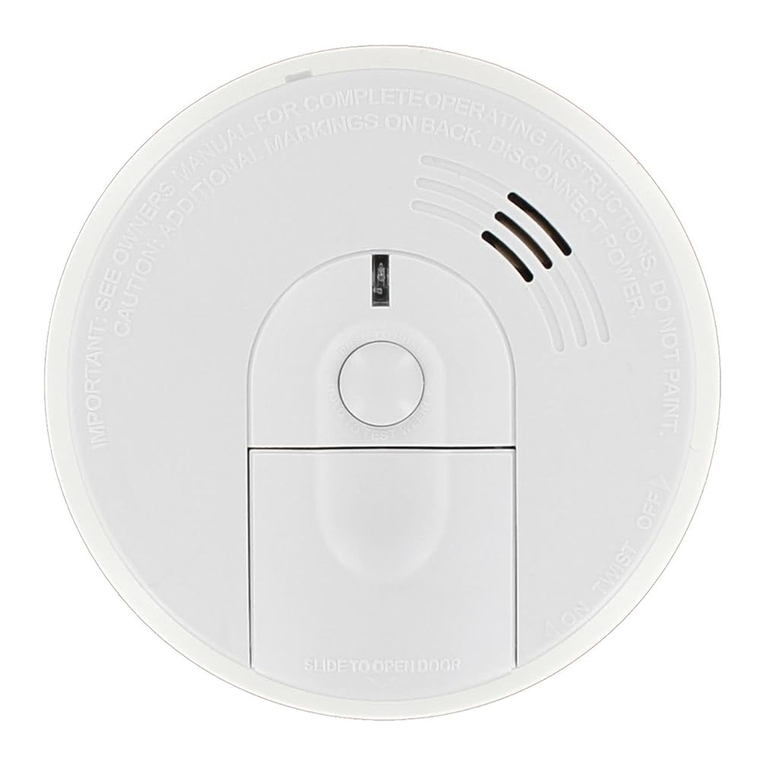
Kidde
Kidde i4618AC user manual

Simplex
Simplex 4099-9004 quick start guide
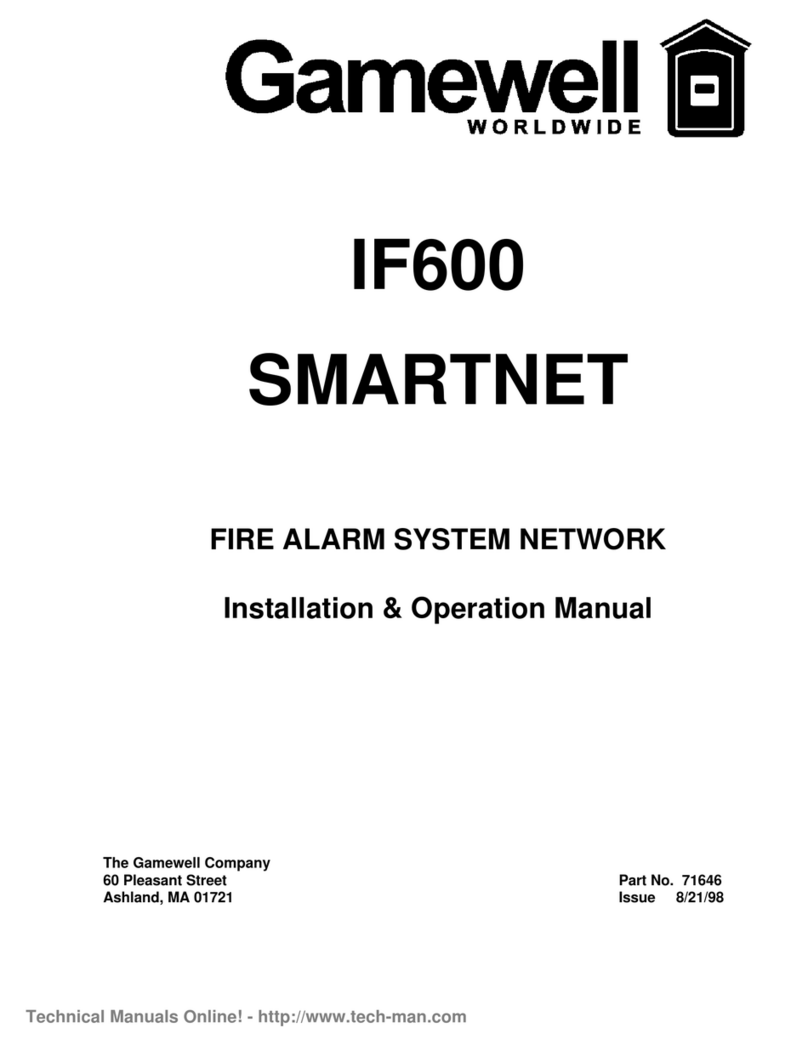
Gamewell
Gamewell IF600 Installation & operation manual
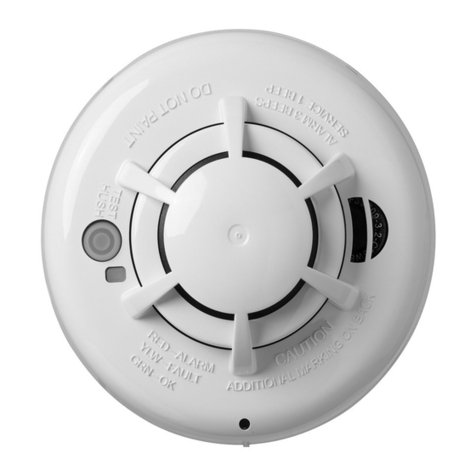
Tyco
Tyco Visonic SMD-429 PG2 Series Installation and operating instructions
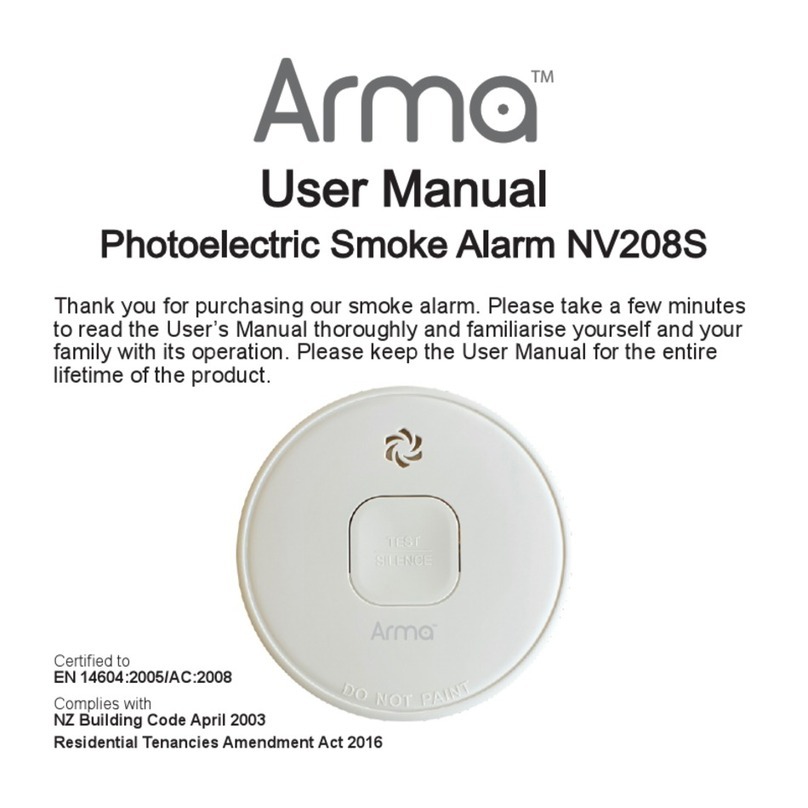
ARMA
ARMA MV208S user manual


